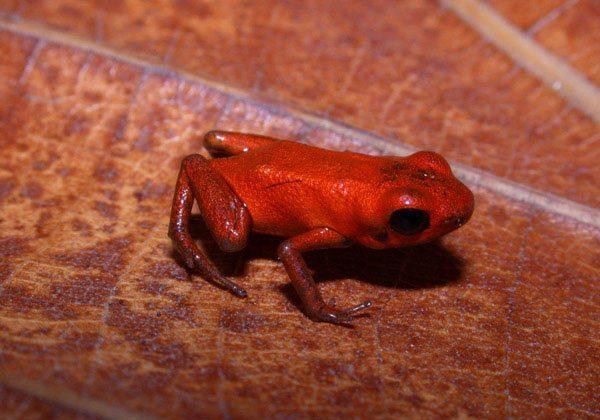It was a surprising discovery in an unlikely location. In a leaf litter nearly four inches deep under a dense canopy of rainforest trees, researchers Marcos Ponce and Abel Batista with the Universidad Autónoma de Chiriquí worked to complete an inventory of endangered species in Panama’s Isthmian-Atlantic moist forest. But they were both completely unsuspecting of what they were about to find: a new poison dart frog.
Because of their eye-catching colors and toxicity, poison dart frogs are some of the most well known amphibians. There are currently 56 species and they are present only in the Neotropical forests from Nicaragua to Bolivia. Most poison dart frogs prefer flat, moist, low-lying areas and can be found under the protective cover of rocks and logs. So when Ponce and Batista discovered the first specimens of Geminis’ poison frog (Andinobates geminisae) on high ground, it was indeed a surprise discovery.
“Abel Batista and Marcos Ponce were the first to note the presence of this species,” said Cesar Jaramillo, herpetologist with the Smithsonian Tropical Research Institute (STRI) and co-author of species description in Zootaxa. “They’ve known it was there for several years. However, they were not sure if it was only a variety of another poison dart frog species, Oophaga pumilio, which exhibits tremendous color variation. Based on morphological characteristics of the adult and the tadpole, I thought it might be a new species of Andinobates geminisae."
So far the new species has only been found in the Río Belén basin in areas of untouched forest. All of these frogs have been seen on ridges of small hills indicating that this particular species prefers higher, drier areas in sharp contrast to its counterparts.
Being part of the Dendrobatidae family, Andinobates geminisae was bound to be brilliant in color, though its unique shade of chrome orange, smooth back, and distinctive male call clearly sets it apart from other species in its genus.
“Many scientists are surprised about this discovery. People thought that it was difficult to find a new species of poison frog in this region of the country,” stated Abel Batista. “In Panama almost all areas are well investigated, and finding a such bright colored frog, gives us the impression that in Panama still a lot of research is needed, principally to investigate those remote areas, that nobody is going to do research.”
“Much of the western slope of the Panamanian Caribbean has been poorly studied and is difficult to access,” Jaramillo further explained, “also, these frogs are very small, making them difficult to observe.”
The scientists celebrated the new species by naming it, Andinobates geminisae, after Marco Ponce’s wife, Geminis Vargas, due to her unwavering support of his studies in Panamanian herpetology. However, celebration surrounding the discovery of this new species was short-lived as attention immediately shifted toward determining a special conservation plan to ensure the species’ survival.
Despite calling an undisturbed, nearly pristine section of forest its home, this new species faces some serious threats to its existence. Indigenous and non-indigenous people alike present challenges to the species. Deforestation by non-indigenous people for agriculture and pasture use threaten the new species’ habitat, while the migration of the native Comarca Ngöbe Buglé people may very well lead them to establish a new settlement in the area, which could increase pressure to the forest. Even more alarming, multinational copper mining companies have recently shown interest in the area.
Unfortunately, deforestation and copper mining aren’t the only concerns for the frogs. The risk of being wiped out by the illegal pet trade is also a very real possibility.
“Data indicates that one of the causes of dispersal is the movement of amphibian species from one place to another, especially for the pet trade. The Dendrobatidae are among the most commercial species because of their bright, striking colors,” warned Jaramillo. “As a single species known for its small distribution and its striking bright color, Andinobates geminisae is extremely desirable to collectors. I’m sure the price for one of these specimens is very high."
Due to it’s vulnerability, the new species is included in the captive breeding program of the Panama Amphibian Rescue and Conservation (PARC) project, a collaboration between eight zoos and research institutions dedicated to maintaining Panama’s amphibian biodiversity. While it is clear that amphibians in this area face many threats, the biggest is still probably the chytrid fungus. An amphibian epidemic that is responsible for frog collapses and extinctions around the world. However, it is still too early to tell if the disease is affecting Andinobates geminisae.
“Since it is a new species, we have no direct data of chytrid fungal disease involvement in this,” said Jaramillo. “But the presence of the fungus has been detected on other species in that area, including other Dendrobatidae.”
Meanwhile, PARC continues to focus its efforts on determining the best approach to reducing the impact of the chytrid fungus on amphibian populations. It is part of PARC’s vision to one day have the opportunity to re-introduce captive frogs back into the wild.
“Poison dart frogs belong to an important part of the food webs of ecosystems, they act as a secondary consumer, feeding on insects, worms, spiders and centipedes,” noted Batista. “Because they eat insects, they are a good defense against undesirable pests.”
These frogs also have many chemicals on their skin that, according to Cesar Jaramillo, have not been largely studied.
“These chemicals can be a source of bioactive agents that may be useful in the control of microorganisms, such as in the production of medicines, in the future,” he said.
Citations:
- Batista, A., JARAMILLO, C. A., PONCE, M., & CRAWFORD, A. J. (2014). A new species of Andinobates (Amphibia: Anura: Dendrobatidae) from west central Panama. Zootaxa, 3866(3), 333-352.
- Huq, S. (2014). Andinobates geminisae. AmphibiaWeb: Information on amphibian biology and conservation. [web application]. Retrieved from http://amphibiaweb.org
This article was originally written and published by Brittany Stewart, a contributing writer for news.mongabay.com. For the original article and more information, please click HERE.

Friends Read Free